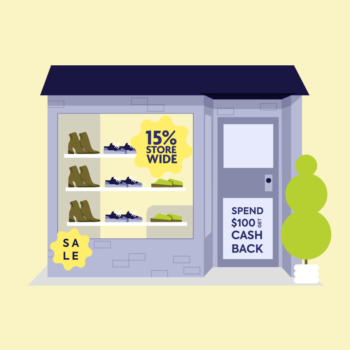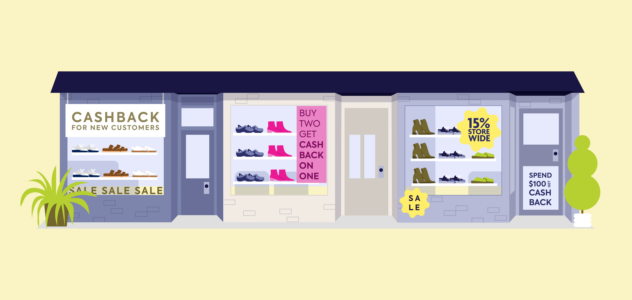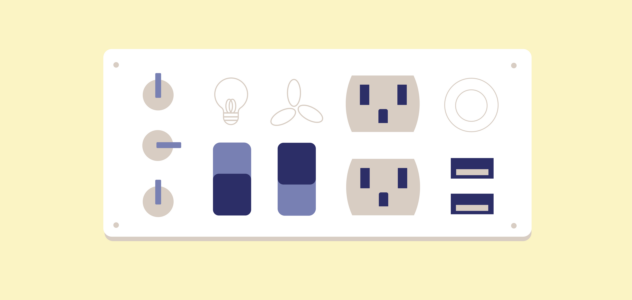LVR calculator
Use this calculator to work out the estimated LVR for your current loan. Simply enter your property value and loan amount below.
What is LVR?
LVR stands for “loan to value ratio”.
The LVR is the ratio of the loan amount to the value of the property that is being used as security for the loan.
Lenders use it as a metric to help assess the overall riskiness of the loan if the unthinkable happens – a customer defaults on their loan and is unable to pay it back, forcing the property to be sold.
In this instance, if the loan represents a large proportion of the property value (i.e. higher LVR), there is a greater likelihood the lender may lose money after the property is sold and other costs incurred.
However, if the value of the property far exceeds the value of the corresponding loan (i.e. lower LVR), then the chance of the lender losing money is significantly less. Therefore, it’s less risky.
How to calculate LVR
Calculating LVR is simple. Take the amount you plan to borrow (or your current loan amount) and divide it by the price of your property.
Let’s break it down.
- Determine the value of the property (generally the lender will use an approved valuation for this)
- Determine the size of the loan (your current loan amount if you’re refinancing)
- Divide the loan amount by the value of the property
Example:
- You estimate your property is worth $950,000.
- Your current loan balance is $700,000
Therefore your LVR is ($700,000 / $950,000) = 73.7% (round it up…74%)
74% is generally considered a ‘low risk’ LVR. More on that later.
Why is LVR important to a lender?
LVR is a fundamental concept used by lenders to determine the riskiness of the loan they are potentially offering a borrower. And when it comes to lending money, it’s all about risk and return.
Lenders are always trying to balance these two factors of risk and return across all of the loans they offer. They will compete harder for lower risk loans, and generally require higher returns for higher risk loans.
They also try to balance their loan portfolios with a mix of risk profiles, to ensure they are not overly exposed to potential changes in the economy or property prices. APRA (banking regulator) also monitors the banks loan portfolios and they don’t particularly like it when banks take on too much high LVR lending either.
Why should you care about LVR as a customer?
If lenders care about LVR, it’s probably worth knowing about. There are a few important reasons why:
It can impact your ability to be approved
Without a big enough deposit for the property you want to purchase, lenders may just give you a flat out no. It can be pretty black and white when it comes to LVR.
If you are approved, you may have to pay Lenders Mortgage Insurance (LMI)
If your LVR is greater than 80%, most lenders will require you to purchase LMI to protect them in case you default on the loan. This insurance can add thousands of dollars to your total mortgage cost and eat into that deposit you have saved so hard for.
It can impact the interest rate you are offered
Back to that concept of risk and return. The more risk the lender takes on, the more return they need to compensate. And how do they make a higher return? Commonly, through a higher interest rate.
So this means that loans with a higher LVR will often come with a higher price tag. And given home loans are large expenses which can last for up to 30 years, even a small difference in interest rates can add up to a big amount of savings over the long term.
For example, below is a comparison of the interest rate differential for a simple variable rate loan with no offset account across the four major banks. Here we show how much extra the banks charge compared to the same loan with an LVR of 60%:
| 70% | 80% | 90% | |
| ANZ | Nil | +0.10% | +1.04% |
| CBA | Nil | +0.17% | +0.92% |
| NAB | Nil | Nil | +1.10% |
| WBC | +0.10% | +0.10% | +0.40% |
As you can see, LVR has a big impact on the interest rate lenders are prepared to offer.
You may be excluded from special offers if you have a high LVR
You’ve probably heard about these juicy cashback offers which lenders offer to entice new customers? Well, bad news is that sometimes these offers come with conditions like a maximum LVR.
Of the major banks, NAB is the only lender where you can still get access to a cashback offer if your LVR is over 80%. All other major lenders will deem you ineligible. There’s that pesky risk and return equation again!
How to calculate your LVR for…
A refinance
Home loan refinancing is very common currently. Particularly for home owners with fixed rate mortgages about to end.
Thankfully, calculating your LVR for a refinance is straightforward and the standard calculation applies.
The only thing to watch for here is that the value of the property may have changed since you initially got your loan.
Your new lender will likely conduct an updated valuation and this will be the figure they use to work out the LVR at the time of refinancing.
A first home buyer
To calculate your LVR as a first home buyer gets a little trickier. You need to understand how much you need to borrow first. Unfortunately this is not the same as the purchase price less your deposit. You will have things like stamp duty, conveyancing fees and potentially some first home owner grants to factor in.
But once you have worked out all the up-front costs and benefits and landed on a final borrowing amount, the calculation is easy. Just divide that amount by the contract purchase price of the property (providing the lender accepts the loan contract price and doesn’t need an additional valuation).
A construction loan
Plans to buy a piece of land and build your dream family home? You know what the land is worth, but the house is not built yet. So how do you calculate your LVR for this scenario?
To work out the property value, lenders generally undertake a valuation of your property as if it were completed. They do this my looking at your building plans and the overall costings to build them. They may also look at comparable properties on the market or recently sold.
So let’s say you buy a piece of land for $500,000 and plan to spend another $500,000 to build the house. In this scenario, providing the valuer deems the property to be worth $1m on completion, this is what the lender will use for the value.
However, if based on similar houses the valuer assesses the property to only be worth $900,000, this is the likely value used by the lender. That’s right, lenders will typically use the lower value between the land plus building cost and the ‘on-completion’ valuation.
A guarantor loan
Home loan guarantees can be very powerful tools to help buyers get into the market with a low deposit (and high LVR).
A common guarantee scenario is with first home buyers. Because, saving money to purchase a home in the current environment is hard yards.
So, let’s say a first home buyer wants to buy a home for $600,000. They have worked hard to save $80,000. They are up for $20,000 in stamp duty and other costs leaving them with a $60,000 deposit (or 10% of the property value).
With a 10% deposit, they would likely have to pay LMI to secure the loan. Given this could be quite expensive, their parents offer to put up a portion of their home as a limited guarantee to get the LVR back to 80% and avoid expensive LMI.
This is how the LVR calculations look for the new home and the parents existing home.
Loan required of $540,000
Total value of securities = $675,000 made up of…
- Property value (new home) = $600,000
- Limited guarantee (parents home) = $75,000
In this example, the LVR for the loan is now 80% ($540,000 / $675,000)
What is a good (and bad) LVR?
As a rule of thumb, the lower the LVR the better. It means the size of the loan compared to the value of the property is lower. Which really means, you have more equity in your property.
80% is the golden number when it comes to LVR. This is the tipping point where lenders generally don’t require you to purchase LMI in order to get the loan to buy the property.
Although there are some exceptions, like first home buyers for example, typically a loan of more than 80% of the property’s value will require a steep up-front cost like LMI.
At or below 80% you are generally considered ‘low risk’ from an LVR perspective. Above 90% is considered ‘high risk’ as property prices don’t have to fall too far before the loan is higher than the value of the property.
What is the maximum LVR lenders will offer?
As with most things home loans, lenders tend to have their own unique policies which make this a tricky one to answer categorically. 95% is a pretty good starting point however (you may find some higher than this if you search hard enough, or ask a good mortgage broker).
There are some more unusual property types which also carry their own policies and maximum LVRs including;
- Size of property: Really small properties, measured by square metre living floorspace, can be seen as more risky by lenders. A common threshold number is 40 square metres. Under this, it can be harder for lenders to obtain Lenders Mortgage Insurance (LMI), and therefore will likely set a maximum LVR of 80%.
- Property concentration: Lenders typically don’t like owning too many individual properties on the same block. For example, in a building of 100 apartments, lenders wouldn’t be too keen to have mortgages against say, 20-30 of them just in case something bad happens. So if you are looking to buy in a large apartment block, the bank may set a maximum LVR.
- Property value: The higher the value of the property, the lower the maximum LVR a lender may be willing to offer. This is more of an issue at the top end of town for the luxury property market (e.g. above $3m – $4m)
- Property location: The maximum LVR for large rural properties could be restricted based on the block size. If the property is designated for commercial purposes or as a source of income, the lender may only approve a loan amount equivalent to 60% of the property’s value.
- Low doc: these loans are generally designed for borrowers who have difficulty providing traditional documentation to prove their income, such as tax returns, financial statements, or payslips. Without as much information, lenders may need to find alternate ways to validate creditworthiness, and to mitigate risk may impose lower maximum LVRs.
If any of these scenarios apply to you, it’s best to get help from a Finspo Expert to discuss your personal situation and see if a solution is available.
How does LMI impact LVR?
LMI is a great tool for helping home buyers get into the property market when they have not yet saved a big deposit to get to 80% LVR. Often customers choose to ‘capitalise’ (read: ‘add’) the LMI premium into the loan amount, which can have an impact on the final LVR of their loan.
Let’s look at an example.
Property price is $500,000 and the customer has got a $50,000 deposit (after paying for stamp duty and fees). This leaves them with a loan amount (pre LMI) of $450,000 and LVR of 90%.
The LMI premium in this case is $15,000 and the customer chooses to capitalise it, or add it, to the loan amount.
This makes the final (post LMI) loan amount $465,000. The final LVR would be 93%.
Lenders typically use this number as the formal LVR to record at the time of settlement and determine any other policies which may apply (e.g. your interest rate).
What if my property value has changed since I got my loan?
Property prices are changing all the time. In Australia over the last 20 years, often going up. So if you are looking to refinance, what property value does the lender use?
The answer is likely the updated one. When you refinance, your new lender will undertake a valuation of your property to validate its current value. And if this is higher than when you bought it (and your loan amount is equal or lower), your LVR will be lower.
This is a common scenario for many Australians who have held their property for some time. And what it means is that by refinancing, you could end up with a lower LVR (which could mean more favourable interest rates).
Another good reason to stay in touch with your home loan to make sure things are working for you.
Now you understand LVR and how to calculate it, is it time to take the plunge on that refinance or home purchase? If so, get started now – all online.
Figures current as at 24th March 2023.
Finspo ABN 34 637 821 928 Australian Credit Licence 521120.
Things you need to know: This information is general only and is not intended to include any recommendation or suggestion about any particular credit product. It does not take into account your financial situation, requirements, and objectives. Please consider whether this information is right for you before making any decisions and seek professional tax or financial advice.












































































































